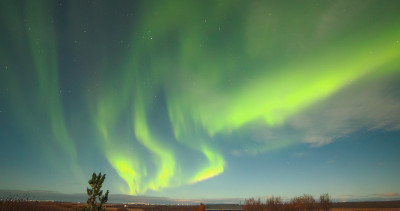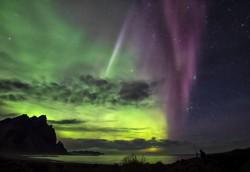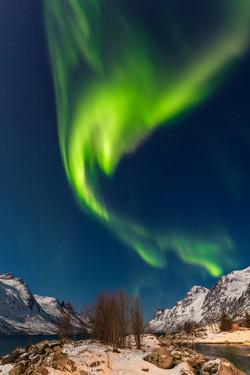Glossary term: Aurore
Description: Une aurore est un phénomène lumineux diffus de couleur variable dans l'atmosphère terrestre, principalement dans les régions polaires. Au nord, on parle d'aurores boréales, au sud d'aurores australes. Les aurores varient en couleur du blanc verdâtre au rouge. Elles se produisent principalement à des altitudes d'environ 100 kilomètres et se forment autour de deux ovales auroraux irréguliers centrés sur les pôles magnétiques de la Terre. Elles se produisent lorsque des particules chargées provenant du vent solaire ou d'éjections de masse coronale (CME) sont piégées dans la magnétosphère terrestre, concentrées par les champs magnétiques de la haute atmosphère et spiralées le long des lignes du champ magnétique terrestre en direction des pôles. Leurs interactions avec les atomes et les molécules de l'atmosphère produisent les émissions aurorales. Cet effet est renforcé pendant les périodes de forte activité solaire. Des aurores ont également été observées sur d'autres planètes du système solaire, notamment sur Jupiter et Saturne.
Related Terms:
See this term in other languages
Term and definition status: The original definition of this term in English have been approved by a research astronomer and a teacher The translation of this term and its definition is still awaiting approval
This translation is based on an older version of the English glossary term and definition
The OAE Multilingual Glossary is a project of the IAU Office of Astronomy for Education (OAE) in collaboration with the IAU Office of Astronomy Outreach (OAO). The terms and definitions were chosen, written and reviewed by a collective effort from the OAE, the OAE Centers and Nodes, the OAE National Astronomy Education Coordinators (NAECs) and other volunteers. You can find a full list of credits here. All glossary terms and their definitions are released under a Creative Commons CC BY-4.0 license and should be credited to "IAU OAE".
If you notice a factual or translation error in this glossary term or definition then please get in touch.
Related Media
Till the End of the World, by Hang Li, China
Credit: Hang Li/IAU OAE
License: CC-BY-4.0 Creative Commons Attribution 4.0 International (CC BY 4.0) icons
Sous les étoiles avec Steve, par Sheila Wiwchar, Canada
Credit: Wiwchar, Sheila ; AIU OAE
License: CC-BY-4.0 Creative Commons Attribution 4.0 International (CC BY 4.0) icons
Icelandic Rivers of Light, by Sergio Díaz Ruiz, Spain
Credit: Sergio Díaz Ruiz/IAU OAE
License: CC-BY-4.0 Creative Commons Attribution 4.0 International (CC BY 4.0) icons
Aurore multicolore en Islande, par Marco Migliardi pour l'Associazione Astronomica Cortina, Italie
Credit: Marco Migliardi au nom de l'Associazione Astronomica Cortina/IAU OAE.
License: CC-BY-4.0 Creative Commons Attribution 4.0 International (CC BY 4.0) icons
Northern light dragon over Ersfjordbotn/Norway
Credit: Rainer Sparenberg/IAU OAE
License: CC-BY-4.0 Creative Commons Attribution 4.0 International (CC BY 4.0) icons













